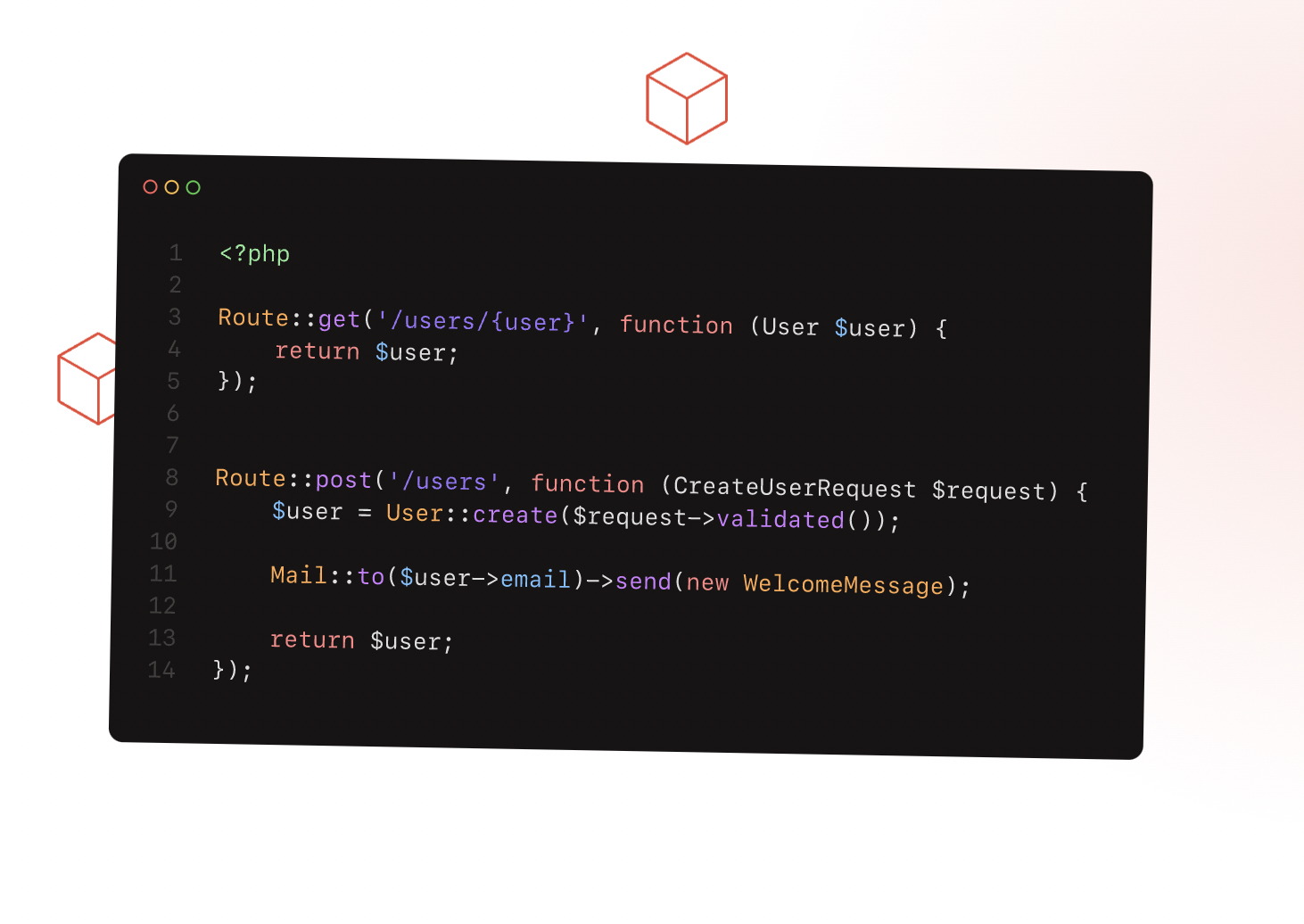- RouteServiceProvidorが削除された背景
- Laravel11で独自のルーティングファイルを定義し、追加する方法
- フレームワークの処理まで徹底解説
RouteServiceProvidorが削除された背景
まず、Laravel11より前では5つのプロパイダーが存在していました。
AuthServiceProviderBroadcastServiceProviderEventServiceProviderRouteServiceProviderAppServiceProvider
RouteServiceProvidorに独自で作成したルーティングファイルを読み込ませることで定義することができます。
<?php
namespace App\Providers;
use Illuminate\Foundation\Support\Providers\RouteServiceProvider as ServiceProvider;
use Illuminate\Support\Facades\Route;
class RouteServiceProvider extends ServiceProvider
{
public function boot(): void
{
$this->routes(function () {
Route::middleware('web')
->group(base_path('routes/web.php'));
Route::prefix('api')
->middleware('api')
->group(base_path('routes/api.php'));
// 独自のルーティングファイルを読み込む
Route::middleware('web')
->group(base_path('routes/custom.php'));
});
}
}
しかし、Laravel11ではこれがbootstrap/app.phpに実装するよう変更されました。
return Application::configure(basePath: dirname(__DIR__))
->withRouting(
web: __DIR__.'/../routes/web.php',
commands: __DIR__.'/../routes/console.php',
health: '/up',
)
->withMiddleware(function (Middleware $middleware) {
//
})
->withExceptions(function (Exceptions $exceptions) {
//
})->create();Laravel 11では、アプリケーションの設定や構成を一元化し、開発者がより直感的に管理できるよう、bootstrap/app.phpファイルが強化されました。これに伴い、ルーティングのカスタマイズや他の設定が従来の場所からbootstrap/app.phpに移行されています。

Laravel11で独自のルーティングファイルを定義し、追加する方法
次にカスタムルーティングファイルを作成します。今回はroutes/auth.phpを作成し、解説します。
<?php
use Illuminate\Support\Facades\Route;
Route::get('/', function () {
dd('Auth Routing');
});
bootstrap/app.phpに作成したroutes/auth.phpを追加します。middlewareやprefixは適正なものを指定してください。
<?php
use Illuminate\Foundation\Application;
use Illuminate\Foundation\Configuration\Exceptions;
use Illuminate\Foundation\Configuration\Middleware;
use Illuminate\Support\Facades\Route;
return Application::configure(basePath: dirname(__DIR__))
->withRouting(
web: __DIR__.'/../routes/web.php',
api: __DIR__.'/../routes/api.php',
commands: __DIR__.'/../routes/console.php',
health: '/up',
// 追加
using: function () {
Route::middleware('api')
->prefix('auth')
->group(base_path('routes/auth.php'));
}
)
->withMiddleware(function (Middleware $middleware) {
//
})
->withExceptions(function (Exceptions $exceptions) {
//
})->create();
この結果、実際にアクセスしてみると、独自で作成したカスタムルーティングファイルが読み込まれています!

フレームワークの構造まで徹底解説
最後に、Laravel11で追加されたwithRoutingメソッド。一体何をしているのでしょうか?
メソッドの実装は以下のようになっています。本記事に関わるところを順序立てて解説します。
Closureを使用しているため、知らないよという方は以下記事を参考にしてください。
/**
* Register the routing services for the application.
*
* @param \Closure|null $using
* @param array|string|null $web
* @param array|string|null $api
* @param string|null $commands
* @param string|null $channels
* @param string|null $pages
* @param string $apiPrefix
* @param callable|null $then
* @return $this
*/
public function withRouting(?Closure $using = null,
array|string|null $web = null,
array|string|null $api = null,
?string $commands = null,
?string $channels = null,
?string $pages = null,
?string $health = null,
string $apiPrefix = 'api',
?callable $then = null)
{
if (is_null($using) && (is_string($web) || is_array($web) || is_string($api) || is_array($api) || is_string($pages) || is_string($health)) || is_callable($then)) {
$using = $this->buildRoutingCallback($web, $api, $pages, $health, $apiPrefix, $then);
if (is_string($health)) {
PreventRequestsDuringMaintenance::except($health);
}
}
AppRouteServiceProvider::loadRoutesUsing($using);
$this->app->booting(function () {
$this->app->register(AppRouteServiceProvider::class, force: true);
});
if (is_string($commands) && realpath($commands) !== false) {
$this->withCommands([$commands]);
}
if (is_string($channels) && realpath($channels) !== false) {
$this->withBroadcasting($channels);
}
return $this;
}1.ルーティングの定義を決定
if (is_null($using) && (is_string($web) || is_array($web) || is_string($api) || is_array($api) || is_string($pages) || is_string($health)) || is_callable($then)) {
$using = $this->buildRoutingCallback($web, $api, $pages, $health, $apiPrefix, $then);
if (is_string($health)) {
PreventRequestsDuringMaintenance::except($health);
}
}条件の確認
$usingが未指定の場合、$web、$api、$pages、$healthなどが指定されていれば、buildRoutingCallbackを使ってルーティングの定義を構築。$thenが指定されている場合も同様。
ヘルスチェックの例外設定
$healthが指定されている場合、メンテナンスモード中でもアクセス可能にするための例外が登録されます。AWS等でヘルスチェックしている場合はとても便利。開発者が意識しなくても勝手にやってくれるLaravelは最高。
2.カスタムルーティングの登録
AppRouteServiceProvider::loadRoutesUsing($using);AppRouteServiceProvider の loadRoutesUsing メソッドを通じて、ルーティングの設定を登録します。$using にカスタムルーティング定義が渡されます。
/**
* Register the callback that will be used to load the application's routes.
*
* @param \Closure|null $routesCallback
* @return void
*/
public static function loadRoutesUsing(?Closure $routesCallback)
{
self::$alwaysLoadRoutesUsing = $routesCallback;
}loadRoutesUsing メソッドは、ルートの読み込み時に実行されるコールバック(Closure)を登録します。このコールバックを設定することで、アプリケーションのルート定義を動的にカスタマイズすることができます。天才ですね。
3.ルーティングの登録
最後はLaravelアプリケーションのインスタンス($this->app)にAppRouteServiceProviderを登録してルーティング設定完了です!
$this->app->booting(function () {
$this->app->register(AppRouteServiceProvider::class, force: true);
});まとめ
Laravel11で独自のカスタムルートファイルを追加する方法とフレームワーク処理まで解説しました。
ヘルスチェックの例外設定を見て、確かに必要だよなと思わされた次第です。
様々なことを想定して作られているのがLaravelなので、先人から学んでいきたいですね



